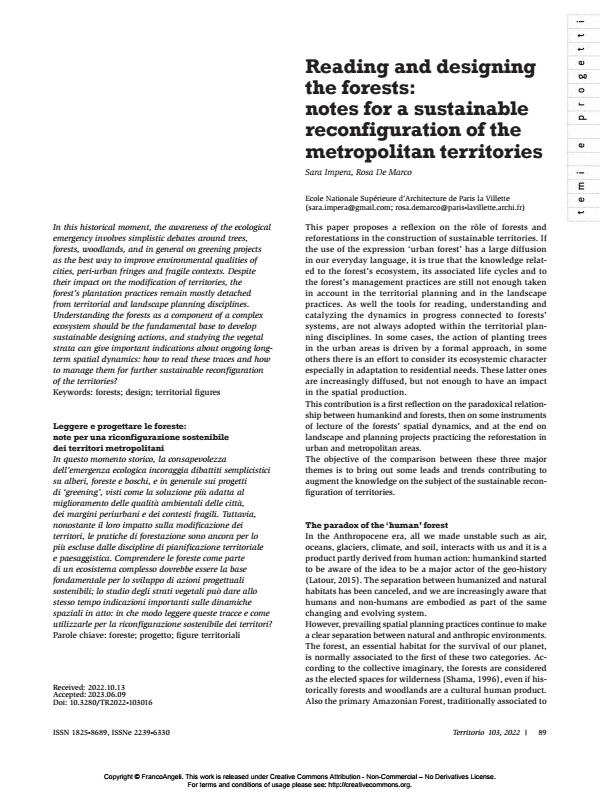Reading and designing the forests: notes for a sustainable reconfiguration of the metropolitan territories
Titolo Rivista TERRITORIO
Autori/Curatori Sara Impera, Rosa De Marco
Anno di pubblicazione 2023 Fascicolo 2022/103
Lingua Inglese Numero pagine 5 P. 89-93 Dimensione file 345 KB
DOI 10.3280/TR2023-103016
Il DOI è il codice a barre della proprietà intellettuale: per saperne di più
clicca qui
Qui sotto puoi vedere in anteprima la prima pagina di questo articolo.
Se questo articolo ti interessa, lo puoi acquistare (e scaricare in formato pdf) seguendo le facili indicazioni per acquistare il download credit. Acquista Download Credits per scaricare questo Articolo in formato PDF

FrancoAngeli è membro della Publishers International Linking Association, Inc (PILA)associazione indipendente e non profit per facilitare (attraverso i servizi tecnologici implementati da CrossRef.org) l’accesso degli studiosi ai contenuti digitali nelle pubblicazioni professionali e scientifiche
In this historical moment, the awareness of the ecological emergency involves simplistic debates around trees, forests, woodlands, and in general on greening projects as the best way to improve environmental qualities of cities, peri-urban fringes and fragile contexts. Despite their impact on the modification of territories, the forest’s plantation practices remain mostly detached from territorial and landscape planning disciplines. Understanding the forests as a component of a complex ecosystem should be the fundamental base to develop sustainable designing actions, and studying the vegetal strata can give important indications about ongoing long- term spatial dynamics: how to read these traces and how to manage them for further sustainable reconfiguration of the territories?
In questo momento storico, la consapevolezza dell’emergenza ecologica incoraggia dibattiti semplicistici su alberi, foreste e boschi, e in generale sui progetti di ‘greening’, visti come la soluzione più adatta al miglioramento delle qualità ambientali delle città, dei margini periurbani e dei contesti fragili. Tuttavia, nonostante il loro impatto sulla modificazione dei territori, le pratiche di forestazione sono ancora per lo più escluse dalle discipline di pianificazione territoriale e paesaggistica. Comprendere le foreste come parte di un ecosistema complesso dovrebbe essere la base fondamentale per lo sviluppo di azioni progettuali sostenibili; lo studio degli strati vegetali può dare allo stesso tempo indicazioni importanti sulle dinamiche spaziali in atto: in che modo leggere queste tracce e come utilizzarle per la riconfigurazione sostenibile dei territori?
Parole chiave:foreste; progetto; figure territoriali
Sara Impera, Rosa De Marco, Reading and designing the forests: notes for a sustainable reconfiguration of the metropolitan territories in "TERRITORIO" 103/2022, pp 89-93, DOI: 10.3280/TR2023-103016